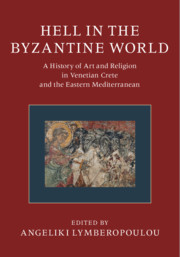 Hell in the Byzantine World
Hell in the Byzantine World from Part II - Eastern Mediterranean
Published online by Cambridge University Press: 02 October 2021
Athanasios Semoglou examines the role of sponsorship and its influence on the iconographical depiction in Byzantine (Greek) Macedonia, arguing that donors affect the use and character of the monument chosen as their burial place. Semoglou vividly demonstrates the connection between the iconography of Hell and the hopes of the faithful for eternal life, which consists a strong motivation for donors to commission images of the Last Judgement. According to the author, the influence of sponsorship on the iconography of Hell can be detected in the illustration of parable of the Rich Man and the Poor Lazarus (Luke 16:19–31), the earliest example of which is found in the Church of Saint Stephen in Kastoria, dated to the end of the 9th or the beginning of the 10th century. Furthermore, the author asserts that during the middle Byzantine period two major changes occurred that led to the articulation of the dipole between sin/punishment and virtue/reward, the first being the consolidation of the Last Judgement in the narthex and the second its vertical alignment, both dominant characteristics in its later representations.
To save this book to your Kindle, first ensure no-reply@cambridge.org is added to your Approved Personal Document E-mail List under your Personal Document Settings on the Manage Your Content and Devices page of your Amazon account. Then enter the ‘name’ part of your Kindle email address below. Find out more about saving to your Kindle.
Note you can select to save to either the @free.kindle.com or @kindle.com variations. ‘@free.kindle.com’ emails are free but can only be saved to your device when it is connected to wi-fi. ‘@kindle.com’ emails can be delivered even when you are not connected to wi-fi, but note that service fees apply.
Find out more about the Kindle Personal Document Service.
To save content items to your account, please confirm that you agree to abide by our usage policies. If this is the first time you use this feature, you will be asked to authorise Cambridge Core to connect with your account. Find out more about saving content to Dropbox.
To save content items to your account, please confirm that you agree to abide by our usage policies. If this is the first time you use this feature, you will be asked to authorise Cambridge Core to connect with your account. Find out more about saving content to Google Drive.